Relationship between Disintegration Characteristics and Intergranular Suction in Red Soil
Abstract
1. Introduction
2. Research on Disintegration Characteristics
2.1. Factors Influencing Red Soil Disintegration
2.1.1. Water
Initial Moisture Content
Wet-Dry Cycle
Moisture Content of Remoulded Soil
2.1.2. Temperature
2.1.3. Pore Air Pressure
2.1.4. Mineral Composition
2.1.5. Microstructure Change
2.1.6. pH
2.1.7. Multifactor
2.2. Disintegration Testing Methods
2.2.1. Laboratory Test
2.2.2. Numerical Method
3. Studies of Intergranular Suction Characteristics
3.1. Theoretical Studies
3.2. Experimental Studies
3.2.1. Direct Testing Methods
Hygrometer Method
Tensiometer Method
Pressure Plate Method
3.2.2. Indirect Testing Method
Filter Paper Method
Heat Conduction Sensing Method
Time Domain Reflectometry Method/TDR
3.2.3. Cross-Technical Test Method
4. Research on the Relationship between Disintegration Characteristics and Intergranular Suction
5. Problems in the Existing Research
- Compared with the systematic disintegration test standards of soft rock, such as clay rock and shale, no uniform standard exists for testing the disintegration of red soil, especially quantitative testing. Although many scholars have designed different testing devices, the accuracy is unsatisfactory.
- Red soil is the product of the parent rock in long-term leaching and weathering, and the climate environment is a key factor affecting its geotechnical nature and water stability. The disintegration characteristics of fresh undisturbed soil and soil with different degrees of weathering are notably different. The existing studies only rarely consider the influence of climate factors on soil disintegration, and the conclusions obtained are slightly different from the actual situation.
- The disintegration of the red soil is controlled by the parent rock types, material composition, structural characteristics and other factors, and the corresponding mechanism is highly complex. Although scholars have examined this aspect from various perspectives, such as by using the unsaturated soil theory, the influence of material composition and fractal theory, a unified understanding has not been achieved. Therefore, the evaluation methods and analysis techniques for the mechanism of red soil disintegration must be further examined.
- The research on the disintegration mechanism of red soil is still in the macro stage, involving the consideration of the different disturbance states, moisture contents, soil compaction degrees, water temperature and other conditions directly influencing disintegration characteristics. Soil disintegration characteristics have not been extensively analysed from the micro perspective (including pore structure and distribution, fracture development degree and particle arrangements).
- The analysis of the intergranular suction of unsaturated soils is conducted considering sandy soil with sand particles that are considered spherical. The most notable difference between clay and sandy and silty soils is that the shape of the particles in the former type is mostly lamellar, and, thus, the assumption of sphericity is not applicable. Moreover, the existing intergranular suction constitutive model is not suitable for red soil structures. Thus, it is necessary to study the microstructure of red soil to clarify the essence of intergranular suction.
- The current research has not fully focused on that the essence of soil disintegration is the gradual loss of the internal intergranular suction, including absorbed suction and structural suction.
- The key objective of the quantitative microscopic study of intergranular suction and disintegration is to establish constitutive equations consistent with the macroscopic mechanical mechanisms and enhance the mechanics of unsaturated soil based on microscopic morphology. Therefore, it is necessary to comprehensively examine the macroscopic physical and mechanical properties of unsaturated soil to study intergranular suction from a microscopic viewpoint.
6. Summary and Conclusions
- The key to testing intergranular suction (including matric suction and other suction types) is to describe the contact type of the particles and identify the geometric characteristics of the bending surface between the particles. At present, the microwork is mostly based on dry soil, and the calculation of intergranular suction between particles after the reconstruction of the microstructure is not in agreement with the nature of unsaturated soil. Future research directions pertain to the direct scanning and reconstruction of undisturbed and unsaturated soil and the measurement of intergranular suction. Microscopic tomography technology can be used to reconstruct the three-dimensional microstructure of wet soil, and this aspect can promote the development of microscopic scanning technology.
- The liquid bridge in unsaturated soil must attain an equilibrium state under the action of the gas and liquid phases; however, the dynamic process of the liquid bridge in unsaturated soil reaching the equilibrium state is not clear. A relatively ideal quantitative and qualitative description method for the change in the liquid bridge must be established in future work.
- The mechanical properties of disintegration must be determined considering the dynamic structure evolution of the liquid bridge between red soil particles and the distribution characteristics of suction force chains.
- Researchers must focus on the stress transfer (redistribution) law and tension–shear coupling failure law of unsaturated red soil in the process of disintegration, perform theoretical research on the progressive failure of unsaturated soil and establish an evaluation method for soil disintegration.
- Both intergranular suction and disintegration are caused by dynamic changes in the gas, liquid and solid phases. Therefore, to examine the failure mechanism of residual soil, analyses must be conducted from the perspective of intergranular suction.
Author Contributions
Funding
Informed Consent Statement
Data Availability Statement
Conflicts of Interest
References
- Cabrera, J.G.; Malomo, S. Strength characteristics of a tropical Red Soil from Northeast Brazil. J. Min. Geol. 1980, 17, 197–208. [Google Scholar]
- Cao, Z.; Zhu, X. Aspects of red soil properties and water management in China. Int. Agrophys. 1999, 13, 241–246. [Google Scholar]
- Pankhurst, C.E.; Pierret, A.; Hawke, B.G.; Kirby, J.M. Microbiological and chemical properties of soil associated with macropores at different depths in a red-duplex soil in NSW Australia. Plant Soil 2002, 238, 11–20. [Google Scholar] [CrossRef]
- Trapnell, C.G.; Webster, R.; Hesse, P.R. Microaggregates in red earths and related soils in East and Central Africa, their classification and occurrence. Eur. J. Soil Sci. 2010, 37, 109–123. [Google Scholar] [CrossRef]
- Wiseman, G.; Zeitlen, J.G.; Komornik, A. Investigation methods used in Israe1 for problematic soils. In Proceedings of the International Conference on Engineering Problems, Beijing, China, 11–15 August 1988; pp. 723–728. [Google Scholar]
- Ali, M.M. Identifying and Analyzing Problematic Soils. Geotech. Geol. Eng. 2011, 29, 343–350. [Google Scholar] [CrossRef]
- Kong, L.W.; Chen, Z.H. Advancement in the techniques for special soils and slopes. China Civ. Eng. J. 2012, 45, 141–159. [Google Scholar]
- Chen, Z.H.; Guo, N. New developments of mechanics and application for unsaturated soils and special soils. Rock Soil Mech. 2019, 40, 1–54. [Google Scholar]
- Evans, R.D.; Jefferson, I.; Northmore, K.J.; Jackson, P. In-situ investigation of problematical soils. In Proceedings of the Advances in Geotechnical Engineering: The Skempton Conference, London, UK, 29–31 March 2004; pp. 1269–1279. [Google Scholar]
- Zhu, X.M. Red clay and red residuum in South China. Quat. Sci. 1993, 1, 75–84. [Google Scholar]
- Kong, L.W.; Sayem, H.M.; Tian, H.H. Influence of drying-wetting cycles on soil-water characteristic curve of undisturbed granite residual soils and microstructure mechanism by nuclear magnetic resonance (NMR) spin-spin relaxation time (T2) relaxometry. Can. Geotech. J. 2018, 55, 208–216. [Google Scholar] [CrossRef]
- An, R.; Kong, L.W.; Li, C.S.; Luo, X.Q. Strength attenuation and microstructure damage of granite residual soils under hot and rainy weather. Chin. J. Rock Mech. Eng. 2020, 39, 1902–1911. [Google Scholar]
- Chen, Z.H. On basic theories of unsaturated soils and special soils. Chin. J. Geotech. Eng. 2014, 36, 201–271. [Google Scholar]
- Soil Survey, S. Keys to Soil Taxonomy, 11th ed.; USDA: Washington, DC, USA, 2010. [Google Scholar]
- Cassell, F.L. Slips in fissured clay. In Proceedings of the Second International Conference on Soil Mechanics and Foundation Engineering, Rotterdam, The Netherlands, 21–30 June 1948. [Google Scholar]
- Dudley, J.H. Review of collapsing soils. J. Soil Mech. Found. Eng. 1970, 96, 925–947. [Google Scholar] [CrossRef]
- Foss, I. Red soil from Kenya as a foundation material. Proceedings of 8th International Conference on Soil Mechanics and Foundation Engineering, Moscow, Russia, 15–19 August 1973. [Google Scholar]
- Yudhbir, Y. Collapsing behaviour of collapsing soils. Proceeding of the 7th Southeast Asia Geotechnical Conference, Hong Kong, China, 22–26 November 1982. [Google Scholar]
- Popescu, M.E. A comparison between the behaviour of swelling and of collapsing soils. Eng. Geol. 1986, 23, 145–163. [Google Scholar] [CrossRef]
- Lawton, E.C.; Fragaszy, R.J.; Hardcastle, J.H. Collapse of compacted clayey sand. J. Geotech. Eng. 1989, 115, 1252–1267. [Google Scholar] [CrossRef]
- Tadepalli, R.; Fredlund, D.G. The collapse behaviour of a compacted soil during inundation. Can. Geotech. J. 1991, 28, 477–488. [Google Scholar] [CrossRef]
- Lawton, E.C.; Fragaszy, R.J.; Hetherington, M.D. Review of wetting induced collapse in compacted soils. J. Geotech. Eng. 1992, 118, 1376–1394. [Google Scholar] [CrossRef]
- Wang, M. The interaction between water and clay particles in saturated clayey soils. Hydrogeol. Eng. Geol. 1987, 3, 5–16. [Google Scholar]
- Wang, Y.; Wang, Y. Effects of soil-water interaction on the flow in soil fissure. Chin. J. Rock Mech. Eng. 1999, 18, 554–557. [Google Scholar]
- Wang, Z.; Gong, B.W.; Bao, C.G. Measurement of matrix suction of expansive soil slope in Northern Hubei. Chin. J. Geotech. Eng. 2001, 25, 304–307. [Google Scholar]
- Liao, Y.L. Interaction between three phases of cohesive soil and its effects on related indexes. Geotech. Investig. Surv. 2001, 6–8. [Google Scholar]
- Zhang, X.G.; Wu, H.; Fang, C. Analysis of X-Ray Diffraction on Variation of Soil Ministructure and Interaction Between Groundwater and Soil. J. Guilin Univ. Technol. 2005, 25, 37–40. [Google Scholar]
- Hu, G.F.; Wang, J.; Cai, X.F. Advances in the Effects of Initial Water Content on Soil Erosion. Guizhou Agric. Sci. 2013, 41, 100–103. [Google Scholar]
- Liu, D.W.; Xiong, C.R. Experimental Study on Properties of Red Sandstone for Road Applications. Cent. South Highw. Eng. 2002, 22, 19–22. [Google Scholar]
- Zheng, M.Z. Disintegration Behavior of Residual Soil and Nonlinear Time Series Analysis for Its Slope Displacement. Master’s Thesis, Fuzhou University, Fuzhou, China, 2005. [Google Scholar]
- Cai, X.L. Study on disintegration characteristics of granite residual soil. Water Conserv. Sci. Technol. Econ. 2010, 16, 882–883. [Google Scholar]
- Xue, L.; Li, X.H. Study on Disintegrating Property of Granodiorite Residual Soil and Completely Strong Weathered Rock. Subgrade Engineering 2011, 144–147. [Google Scholar]
- Zeng, P. A Study Compaction Characteristics and Disintegration Behavior of Granite Residual Soil. Master’s Thesis, South China University of Technology, Guangzhou, China, 2012. [Google Scholar]
- Jian, W.B.; Hu, H.R.; Luo, Y.H.; Tang, W.Y. Experimental study on deterioration of granitic residual soil strength in wetting-drying cycles. J. Eng. Geol. 2017, 25, 592–597. [Google Scholar]
- Li, C.S.; An, R.; Shu, R.J.; Kong, L.W. Initial-disintegration analysis of granite residual soil and approximate simulation of mathematical morphology. Chin. J. Rock Mech. Eng. 2020, 39, 201–210. [Google Scholar]
- Liu, D.L.; Zhao, Y.; Ding, S.W.; Deng, Y.S.; Wang, Q.X.; Lv, G.A. Correlation between initial soil moisture content and the characteristics of collapsing gullies in granite regions. Sci. Soil Water Conserv. 2016, 14, 17–22. [Google Scholar]
- Li, Z.; Liu, Y.W.; Zhao, J.F. In-door Experiment of Granite Weathered Residual Soil Disintegration at Sea-cliff. Water Power 2018, 44, 107–110. [Google Scholar]
- Zhou, C.Y.; Jing, X.D.; Liu, Z. Disintegration characteristics and modification of weathered soil in red beds in Southern China. J. Eng. Geol. 2019, 27, 1253–1261. [Google Scholar]
- Wang, Y.F.; Niu, J. Soil Disintegration Rate in the Upper and Middle Reaches of the Yangtze River. J. Yangtze River Entific Res. Inst. 2015, 32, 40–43. [Google Scholar]
- Zhu, Z.Y.; He, G.C.; Li, F.X.; Wang, Z. Experimental Investigation on the Failure Mechanism of Red Soil Slope under Cyclic Wetting and Drying. J. Yangtze River Sci. Res. Inst. 2018, 35, 73–77. [Google Scholar]
- Zhang, F.Z.; Chen, X.P. Influence of repeated drying and wetting cycles on mechanical behaviors of unsaturated soil. Chin. J. Geotech. Eng. 2010, 32, 41–46. [Google Scholar]
- Tang, J.; Yu, P.; Wei, H.Z.; Meng, Q.S. Slaking behaviour of weathered basalt residual soil in Guizhou. J. Eng. Geol. 2011, 19, 778–783. [Google Scholar]
- Chen, D.X.; Yang, Y.; Yang, K.; Kang, K.G. Experimental study on strength and water-stable behavior of unsaturated residual soils. In Proceedings of the International Conference on Remote Sensing, Environment and Transportation Engineering, Nanjing, China, 24–26 June 2011. [Google Scholar]
- Zhao, G.G.; Huang, Y.; Zhang, J.F.; Cheng, F.Y.; Zhou, Z.W. Investigation on the Development of Cracks of Laterite of Yunnan Under Wetting-drying Cycles. J. Soil Water Conserv. 2017, 31, 157–165. [Google Scholar]
- Zhang, S.; Zheng, X.Y.; Xiong, D.H.; Zhang, B.J.; Yang, D.; Guo, M.; Jiao, L. The Influence of Dry-wet Alternation on the Disintegration of Different Types of Soil in Gully Development Region of Dry-hot Valley. J. Soil Water Conserv 2016, 30, 111–121. [Google Scholar]
- Yan, B.; Tang, L.S.; Hu, H.; Wang, D.Z.; Lin, G.W. The mechanism of disintegration damage of granite weathered soil. Hydrogeol. Eng. Geol. 2009, 36, 68–70. [Google Scholar]
- Huang, Z.P.; Sun, J.L.; Cao, Y.B.; Zeng, H.J. Temperature effect on strength evolution of saturated granite residual soil. Nonferrous Met. (Min. Sect.) 2017, 69, 54–60. [Google Scholar]
- Zeng, Q.J.; Liu, B.C.; Zhang, B.H.; Xiong, J.H.; Xiao, S.D. An experimental study of the disintegration characteristics of red clay. Hydrogeol. Eng. Geol. 2018, 45, 99–103. [Google Scholar]
- Wang, Y.; Tang, L.S.; Gao, Q.C.; Liao, H.R. Effects of Water-Soil Interaction on Mechanical Strength of Residual Red Clay. Acta Sci. Nat. Univ. Sunyatseni 2007, 46, 128–132. [Google Scholar]
- Zhang, B.H.; Xie, Y.H.; Liu, L. Water absorption of red clay and its influence on the slaking test. Soil Eng. Found. 2020, 34, 98–101. [Google Scholar]
- GambleGamble, J. Durability-Plasticity Classification of Shales and Other Argillaceous Rocks. Ph.D. Thesis, University of Illinois at Urbana-Champaign, Champaign, IL, USA, 1971. [Google Scholar]
- Yamaguchi, H.; Yoshida, K.; Kuroshima, I.; Fukuda, M. Slaking and Shear Properties of Mudstone. Rock Mech. Power Plants 1988, 1, 133–144. [Google Scholar]
- Tang, Q.Y. A Study on the Temperature Effect on the Structural Strength of Granite Residual Red Soil. Master’s Thesis, Jilin University, Changchun, China, 2005. [Google Scholar]
- Zhang, X.W.; Kong, L.W. Experimental investigation on relative contribution of hot and humid weather and heavy rainfall in disintegration of basalt residual soil. Sci. Sin. 2016, 46, 1175–1184. [Google Scholar] [CrossRef]
- Guo, T. Study on Disintegration Properties and Microstructure of Guilin Red Clay under Different Environmental Conditions. Master’s Thesis, Guilin University of Technology, Guilin, China, 2017. [Google Scholar]
- Sun, Y.L.; Tang, L.S.; Liu, J. Advances in research on microstructure and intergranular suction of unsaturated soils. Rock Soil Mech. 2020, 41, 1095–1122. [Google Scholar]
- Chugh, Y.P.; Missavage, R.A. Effects of moisture on strata control in coal mines. Eng. Geol. 1981, 17, 241–255. [Google Scholar] [CrossRef]
- Xia, D.; Zhao, B.Q.; Liu, D.X.; Deng, Y.S.; Cheng, H.; Yan, Y.J.; Ding, S.W.; Cai, C.F. Effect of soil moisture on soil disintegration characteristics of different weathering profiles of collapsing gully in the hilly granitic region, South China. PLoS ONE 2018, 13, e0209427. [Google Scholar] [CrossRef] [PubMed]
- Zhang, X.W.; Kong, L.W.; Li, H.C. Engineering geological properties and micro-mechanism of residual soils derived from mudstone in Harare, Zimbabwe. J. Eng. Geol. 2018, 26, 1424–1432. [Google Scholar]
- Zhang, H.Z.; Liu, J.F. Microstructures, Mineral Compositions, and Mechanical Properties of Red-Layers in Southern China. Adv. Mater. Sci. Eng. 2018, 2018, 9601386. [Google Scholar] [CrossRef]
- Zhang, S.; Tang, H.M. Experimental study of disintegration mechanism for unsaturated granite residual soil. Rock Soil Mech. 2013, 34, 1668–1674. [Google Scholar]
- Deng, Y.; Duan, X.; Ding, S.; Cai, C.; Chen, J. Suction stress characteristics in granite red soils and their relationship with the collapsing gully in south China. Catena 2018, 171, 505–522. [Google Scholar] [CrossRef]
- Reginatto, A.R.; Ferrero, J.C. Collapse potential of soils and soil-water chemistry. Int. J. Rock Mech. Min. Sci. Geomech. 1975, 12, 59. [Google Scholar] [CrossRef]
- Cheng, B.C.; Xu, C.W. Property of the Cementing Material and Its Influence on Mechanical Characteristics for Residual Soil from Granite. Rock Soil Mech. 1986, 7, 64–69. [Google Scholar]
- Wang, Q.; Jiang, H.Z.; Tang, D.X. Study on engineering geological properties of granite residual soil in South Fujian. Geol. Fujian 1990, 9, 90–99. [Google Scholar]
- Wang, Q.; Tang, D.X.; Zhang, Q.Y.; Zhao, J.Z. A study on the material structure and composition of granite residual soils in the eastern China. J. Chang. Univ. Earth Sci. 1991, 21, 73–81. [Google Scholar]
- Chen, Q.; Li, J.; Zhao, L. Experimental Research on Disintegration Characteristics of Weathered Granite in Nanyue Region. Chin. J. Undergr. Space Eng. 2015, 11, 119–124. [Google Scholar]
- Huang, Y.; Fu, B.C.; Fu, J.Q.; Li, Q.S. The Section Properties of the Substance Composition of the Basalt Laterite in Kunming Area. J. Kunming Univ. Sci. Technol. 2000, 25, 88–92. [Google Scholar]
- Liu, C.W.; Lu, S.L. Research on mechanism of mudstone degradation and softening in water. Rock Soil Mech. 2000, 21, 29–31. [Google Scholar]
- Tan, L.R. Discussion on mechanism of disintegration and argillitization of clay-rock. Rock Soil Mech. 2001, 22, 1–5. [Google Scholar]
- Zhou, H.Y.; Li, H.X. The Study on Soil Disintegration Characteristics and Its Influence Factors of Collapsing Wall in the Collapsing Hill Erosion Region of Southern China. J. Soil Water Conserv. 2017, 31, 74–79. [Google Scholar]
- Wang, J.Z. The dffects of free iron Oxides on the engineering properties of red clay. Chin. J. Geotech. Eng. 1983, 5, 147–156. [Google Scholar]
- Jin, X.; Xiong, C.X.; Zhong, F.L. Experimental Study on Disintegration Characteristics of Granite Residual Soil Under Acid Pollution. J. Water Resour. Archit. Eng. 2017, 15, 194–198. [Google Scholar]
- Li, B.; Wu, S.R.; Shi, J.S.; Feng, Z. Engineering geological properties and hazard effects of Hipparion laterite in Baoji, Shaanxi Province. Geol. Bull. China 2013, 32, 1918–1924. [Google Scholar]
- Gao, G.R. The Microstructures and Engineering Properties of Red Soil in China. J. Geotech. Eng. 1985, 7, 10–21. [Google Scholar]
- Feng, J.L.; Zhao, Z.S.; Gao, G.R. An Exploration for Action and Action Mechanisim of Free Ferric Oxide in Laterite. J. Hebei Acad. Sci. 1994, 1, 35–43. [Google Scholar]
- Zhang, Z.; Ma, W.; Zhao, S.P.; Feng, W.J.; Wu, J.J.; Xiao, D.H. Morphological characteristics of the disintegration of cryogenic clay loam, natural and air-dried. J. Glaciol. Geocryol. 2014, 36, 118–122. [Google Scholar]
- Xu, Q.Y.; Wang, H.; Wu, J. Preliminary research on the factors affecting the disintegration characteristics of soil. J. Eng. Geol. 2016, 24, 855–860. [Google Scholar]
- Xu, H.D.; Wu, S.L. Countermeasures for the Prevention and Control of the Disintegration Disaster Caused by the Yuan Baoshan Red Soil in North China. J. China Univ. Min. Technol. 1996, 25, 30–34. [Google Scholar]
- Liu, Z.R.; Liu, C.Y.; Liang, B. Soil Mechanics; Tongji University Press: Shanghai, China, 2005. [Google Scholar]
- Wu, N.S. A study on calving property and softening damage parameter of GRS. J. Hebei Inst. Archit. Sci. Technol. 2006, 23, 58–62. [Google Scholar]
- Zhang, Z.; Ma, W.; Pendin, V.V.; Zhang, Z.Q.; He, R.X. Experimental study of the disintegration characteristics of loam with different moisture content. Hydrogeol. Eng. Geol. 2014, 41, 104–108. [Google Scholar] [CrossRef]
- Yuan, W.; Gao, D. The geotechnical characteristics of red clay. China Civ. Eng. J. 1983, 18, 71–78. [Google Scholar]
- Tang, L.S.; Sang, H.T.; Song, J.; Liu, F.T.; Zhang, P.C. Research on soil particle joint function and brittle-elastoplastic cement damage model of unsaturated granite residual soil. Rock Soil Mech. 2000, 34, 2877–2888. [Google Scholar]
- Tang, L.S. Structure Suction and Principle of General Effective Stress in Unsaturated Soils. Acta Sci. Nat. Univ. Sunyatsen 2000, 39, 95–100. [Google Scholar]
- Tang, L.S. New suggestion on shear strength in unsaturated soil based on suction between grains. Chin. J. Geotech. Eng. 2001, 23, 412–417. [Google Scholar]
- Sun, Y.L.; Tang, L.S. Use of X-ray computed tomography to study structures and particle contacts of granite residual soil. J. Cent. South Univ. 2019, 26, 938–954. [Google Scholar] [CrossRef]
- Ma, L.; Wang, Q.; Yuan, G.H. Fractal geometry research on the effect of pH on granulometric composition of red soil. Hydrogeol. Eng. Geol. 2007, 2, 41–44. [Google Scholar]
- Ma, L.; Wang, Q.; Yuan, G.H. Effect of pH on properties of red soil. J. Harbin Inst. Technol. 2009, 41, 255–258. [Google Scholar]
- Auzet, A.; Kirkby, M.J.; Dijk, P.V. Surface characterisation for soil erosion forecasting. Catena 2005, 62, 77–78. [Google Scholar] [CrossRef]
- Bo, S.Z.; Huang, Y.; Shi, C.X. Variation characteristics of physical properties of acid pollution laterite. Hydrogeol. Eng. Geol. 2012, 39, 111–115. [Google Scholar]
- Ren, L.Q. Study on Macro and Micro Characteristics of Alkali-Contaminated Laterite. Master’s Thesis, Kunming University of Science and Technology, Kunming, China, 2014. [Google Scholar]
- Wang, Z.K.; Gao, W.Z.; Liu, F. Soil Slaking Studies on Samples from Guilin Karst Terrain. Soil Eng. Found. 2017, 31, 59–62. [Google Scholar]
- Guo, Y.F. The anti-disintegration effect of different curing agents on granite residual soil. J. Fujian Agric. For. Univ. 2019, 48, 225–230. [Google Scholar]
- Sun, Y.; Liu, Q.; Xu, H.; Wang, Y.; Tang, L. Influences of different modifiers on the disintegration of improved granite residual soil under wet and dry cycles. Int. J. Min. Sci. Technol. 2022, 32, 831–845. [Google Scholar] [CrossRef]
- Jiang, D.S.; Li, X.H.; Fan, X.K.; Zhang, H.X. Research on the law of soil disintegration rate change an It’s effect factors on the loess plateau. Bull. Soil Water Conserv. 1995, 15, 20–27. [Google Scholar]
- Wang, J.E.; Xiang, W.; Bi, R.N. Experimental study of influence of matric suction on disintegration of unsaturated remolded loess. Rock Soil Mech. 2011, 32, 3258–3262. [Google Scholar]
- Peng, Y.; Zhang, H.Y.; Lin, C.B.; Wang, X.W.; Yang, L. Engineering properties and improvement mechanism of loess soil modified by consolid system. Chin. J. Rock Mech. Eng. 2017, 36, 762–772. [Google Scholar]
- Zhou, X.W.; Liu, P.; Lan, Z. Experimental Study on Disintegration Behavior of Granite Residual Soil. In Proceedings of the Geo-hubei International Conference on Sustainable Civil Infrastructure, Yichang, China, 20–22 July 2014. [Google Scholar]
- Liu, W.P.; Song, X.Q.; Huang, F.M.; Hu, L.N. Experimental study on the disintegration of granite residual soil under the combined influence of wetting-drying cycles and acid rain. Geomat. Nat. Hazards Risk 2019, 10, 1912–1927. [Google Scholar] [CrossRef]
- Lan, Z.X. Experimental Study on Disintegration Behavior of Granite Residual Soil. Master’s Thesis, South China University of Technology, Guangzhou, China, 2013. [Google Scholar]
- Li, C.S.; Kong, L.W.; Shu, R.J.; An, R.; Zhang, X.W. Disintegration characteristics in granite residual soil and their relationship with the collapsing gully in South China. Open Geosci. 2020, 12, 1116–1126. [Google Scholar] [CrossRef]
- Gu, T.F.; Yuan, L.; Hu, W.; Zhu, L.F.; Wang, X. Experimental research on disintegration of the Heifangtai loess. Hydrogeol. Eng. Geol. 2017, 44, 62–70. [Google Scholar]
- Dmitriev, V.V.; Yarg, L.A. Method and Evaluation of Soil Test; Student’s Book: Moscow, Russia, 2008. (In Russian) [Google Scholar]
- Zhang, Z.; Vadim, P.; Svetlana, N.; Zhang, Z.Q.; Wu, J.J. Disintegration characteristics of a cryolithogenic clay loam with different water content: Moscow covering loam (prQIII), case study. Eng. Geol. 2019, 258, 105159. [Google Scholar]
- Tong, D.K.; Feng, D.; Huang, S.Y.; Ji, X.Z. Experimental Investigation of Compacted Soil Disintegration Property. Sci. Technol. Eng. 2018, 18, 129–136. [Google Scholar]
- Li, Q.Y.; Wang, Y.L. Experimental study on some geotechnical humidification characteristics. In Proceedings of the National Engineering Geology Congress, Beijing, China, 21 May 1992. [Google Scholar]
- Wang, N.Q.; Wang, Q.T.; Xue, Q.; Liu, X.L. Experimental study of static disintegration on unsaturated soil. Appl. Mech. Mater. 2014, 580–583, 68–72. [Google Scholar] [CrossRef]
- Li, J.C.; Tian, W.P. Experiment of compacted loess disintegration. J. Chongqing Jiaotong Univ. 2005, 24, 74–77. [Google Scholar]
- Lozano-Pérez, T. Spatial Planning: A Configuration Space Approach; Springer: New York, NY, USA, 1990. [Google Scholar]
- Santaló, L.; Kac, F. Integral Geometry and Geometric Probability; Addison Wesley Publishing Company: Glenview, IL, USA, 1976. [Google Scholar]
- Du, J.; Hou, K.P.; Yang, F. Application of fractal geometry to mechanical properties study of granular material. J. Kunming Univ. Sci. Technol. 2013, 38, 30–35. [Google Scholar]
- Li, J.; Chen, Q.; Liu, Z.; He, C. Experimental research on disintegration characteristics of weathered granite in Nanyue. J. Hunan Univ. Sci. Technol. 2015, 30, 59–64. [Google Scholar]
- Terzaghi, K. Theory of Consolidation. In Fundamentals of Transport Phenomena in Porous Media; Springer: Berlin/Heidelberg, Germany, 1984. [Google Scholar]
- Bishop, A.W. The Principle of Effective Stress. Tek. Ukebl. 1959, 39, 859–863. [Google Scholar]
- Lytton, R.L.; Kher, R.K. Prediction of Moisture Movement in Expansive Clays; Study of Expansive Clays in Roadway Structural Systems: Austin, TX, USA, 1969. [Google Scholar]
- Mondal, S.; Sharma, V.; Apte, P.; Singh, D.N. Electrical analogy for modelling thermal regime and moisture distribution in sandy soils. Geomech. Geoengin. 2017, 13, 22–32. [Google Scholar] [CrossRef]
- Guo, L.H. Investigation of Soil Stabilization Using Biopolymers. Doctoral Dissertation, Iowa State University, Iowa City, IA, USA, 2014. [Google Scholar]
- Richards, T.W.; Coombs, L.B. The Determination of Surface-Tension. Chemistry 1915, 5, 404–407. [Google Scholar]
- Chen, Z.H.; Guo, N. New developments of mechanics and application for unsaturated soils and special soils. Rock Soil Mech. 2018, 40, 1–54. [Google Scholar]
- Fredlund, D.G.; Morgenstern, N.R. Stress state variables for unsaturated soils. J. Geotech. Eng. Div. 1977, 103, 447–466. [Google Scholar] [CrossRef]
- Blight, G.E. Effective stress evaluation for unsaturated soils. J. Soil Mech. Found. Div. 1967, 2, 125–148. [Google Scholar] [CrossRef]
- Van, G. A closed-form equation for predicting the hydraulic conductivity of unsaturated soils. Soil Sci Soc. Am. J. 1980, 44, 892–898. [Google Scholar]
- Fredlund, D.G.; Xing, A. Equations for the soil-water characteristic curve. Can. Geotech. J. 1994, 31, 521–532. [Google Scholar] [CrossRef]
- Lian, G.P.; Thornton, C.; Adams, M.J. A Theoretical Study of the Liquid Bridge Forces between Two Rigid Spherical Bodies. J. Colloid Interface Sci. 1993, 161, 138–147. [Google Scholar] [CrossRef]
- Coelho, R.; Cordeiro, L.; Gazola, R.B.; Teixeira, P. Dynamics of two-dimensional liquid bridges. Soft Condens. Matter 2022, 1, 205001. [Google Scholar] [CrossRef] [PubMed]
- Shen, Z.J. Generalized Suction and Unified Deformation Theory for Unsaturated Soils. Chin. J. Geotech. Eng. 1996, 18, 1–9. [Google Scholar]
- Tang, L.; Wang, S.J. Absorbed suction and principle of effective stress in unsaturated soils. Chin. J. Geotech. Eng. 2000, 22, 83–88. [Google Scholar]
- Lu, N. Profiles of Steady-State Suction Stress in Unsaturated Soils. J. Geotech. Geoenviron. Eng. 2004, 130, 1063–1076. [Google Scholar] [CrossRef]
- Lu, N.; Asce, M.; Likos, W.J. Suction Stress Characteristic Curve for Unsaturated Soil. J. Geotech. Geoenviron. Eng. 2006, 132, 131–142. [Google Scholar] [CrossRef]
- Kim, B.S.; Shibuya, S.; Park, S.W.; Kato, S. Application of suction stress for estimating unsaturated shear strength of soils using direct shear testing under low confining pressure. Can. Geotech. J. 2010, 47, 955–970. [Google Scholar] [CrossRef]
- Song, Y.S.; Hwang, W.K.; Jung, S.J.; Kim, T.H. A comparative study of suction stress between sand and silt under unsaturated conditions. Eng. Geol. 2012, 124, 90–97. [Google Scholar] [CrossRef]
- Lu, N.; Murat, K. A Drying Cake Method for Measuring Suction-Stress Characteristic Curve, Soil-Water-Retention Curve, and Hydraulic Conductivity Function. Geotech. Test. J. 2013, 36, 1–19. [Google Scholar] [CrossRef]
- Luan, M.T.; Li, S.Q.; Yang, Q. Matric suction and tension suction of unsaturated soils. Chin. J. Geotech. Eng. 2006, 28, 864–868. [Google Scholar]
- Jiang, X.L.; Li, P.C. Calculation of intergranular suction considering cementing area between soil particles. Chin. J. Geotech. Eng. 2016, 38, 1160–1164. [Google Scholar]
- Sang, H.T. Intergranular Suction Test of Unsaturated Soil and Its Relationship with Tensile Strength. Ph.D. Thesis, Sun Yat-sen University, Guangzhou, China, 2015. [Google Scholar]
- Sun, Y.L. Study on Suction between Particles of Clay Soil Based on Micro-Tomography Method. Ph.D. Thesis, Sun Yat-sen University, Guangzhou, China, 2018. [Google Scholar]
- Biglari, M.; Ashayeri, I.; Gallipoli, D.; Moradpour, S. A unified small-strain shear stiffness model for saturated and unsaturated soils. Comput. Geotech. 2021, 136, 136–149. [Google Scholar] [CrossRef]
- Yuan, J.P. Transmit Mechanization and Measurement Method of Suction Pressure in Unsaturated Soil. Geotech. Eng. 2003, 15, 27–29. [Google Scholar]
- Xu, J.; Wang, Z.; Li, W.X. The Measuring Techniques of Unsaturated-soil Suction. Chin. J. Rock Mech. Eng. 2000, 19, 905–909. [Google Scholar]
- Chi, F.Q. A new method for determining soil moisture-tensiometer method. Mod. Agric. 1988, 5. [Google Scholar]
- Wang, Z.; Yang, J.X.; Kuang, J.J.; An, J.Y.; Luo, Y.D. Application of filter paper method in field measurement of matric suction. Chin. J. Geotech. Eng. 2003, 25, 405–408. [Google Scholar]
- Lu, N.; Likos, W.J.; Wei, C.F. Mechanics of Unsaturated Soil; Higher Education Press: Beijing, China, 2004. [Google Scholar]
- Gong, B.W.; Bao, C.G. On-Site Observation Technology of Unsaturated Expansive Soils. South-North Water Transf. Water Sci. Technol. 2008, 6, 291–294. [Google Scholar]
- Gunjal, A.; Atrey, M.D.; Srivastava, A. Two-Phase Pressure Drop Study for Cryosurgical Probes Using One-Dimensional Homogeneous Model; IOP Publishing Ltd.: Bristol, UK, 2022; Volume 1240, pp. 1–9. [Google Scholar]
- Brown, R.W.; Collins, J.M. A Screen-Caged Thermocouple Psychrometer and Calibration Chamber for Measurements of Plant and Soil Water Potential. Agron. J. 1980, 72, 851–854. [Google Scholar] [CrossRef]
- Campbell, G.S.; Gardne, W.H. Psychrometric Measurement of Soil Water Potential: Temperature and Bulk Density Effects. Soil Sci. Soc. Am. 1971, 35, 8. [Google Scholar] [CrossRef]
- Albrecht, B.A.; Benson, C.H.; Beuermann, S. Polymer Capacitance Sensors for Measuring Soil Gas Humidity in Drier Soils. Geotech. Test. J. 2003, 26, 3–11. [Google Scholar]
- Zhang, Y.Q. Experimental Research on Infiltration in Unsaturated Loess. Master’s Thesis, Chang’an University, Xi’an, China, 2016. [Google Scholar]
- Segales, A.R.; Chilson, P.B.; Salazar-Cerreno, J.L. Considerations for improving data quality of thermo-hygrometer sensors on board unmanned aerial systems for planetary boundary layer research. Atmos. Meas. Tech. 2022, 15, 2607–2621. [Google Scholar] [CrossRef]
- Ridley, A.M.; Burland, J.B. A new instrument for the measurementof soil moisture suction. Geotechnique 1993, 43, 321–324. [Google Scholar] [CrossRef]
- Becker, T.; Meibner, H. Direct suction measurement in cyclic triaxial test devices. In Unsaturated Soil; Swets & Zeitlinger: Lisse, The Netherlands, 2002. [Google Scholar]
- Muraleetharan, K.; Granger, K. The Use of Miniature Pore Pressure Transducers in Measuring Matric Suction in Unsaturated Soils. Geotech. Test. J. 1999, 22, 226–234. [Google Scholar]
- Marinho, F.A. Discussion on “The use of miniature pore pressure transducers in measuring matrix suction in unsaturated soils” by Muralleetharan K K & Granger K K. Geotech. Test. J. 2000, 23, 532–534. [Google Scholar]
- Li, S.Q.; Jia, H.J.; Wang, X.X.; Gui, C. Limitation and error analysis of axis translation technique for measuring and controlling matric suction. Rock Soil Mech. 2016, 37, 3089–3095. [Google Scholar]
- Sanlon, P.; Sivakumar, V.; Solan, B.; Tripathy, S.; Mackinnon, P.; Donohue, S.; Ramaiah, B.J. Assessment of Skempton’s pore water pressure parameters B and A using a high-capacity tensiometer. Geotechnique 2021, 71, 110–119. [Google Scholar] [CrossRef]
- Rahul, R.; Manikandan, M. Estimation of irrigation interval and soil water content distribution for drip irrigated eggplant using tensiometer under mulching condition. Indian J. Soil Conserv. 2021, 49, 23–31. [Google Scholar]
- Richards, L.A.; Fireman, M. Pressure-Plate Apparatus for Measuring Moisture Sorption and Transmission By Soils. Soil Sci. 1943, 56, 395–404. [Google Scholar] [CrossRef]
- Stevenson, D.S. Unreliabilities of pressure plate 1500 kilopascal data in predicting soil water contents at which plants become wilted in soil-peat mixes. Can. J. Soil Sci. 1982, 62, 415–419. [Google Scholar] [CrossRef]
- Gong, B.W.; Zhou, X.W.; Zhou, W.H. Test on suction and strength of expansive soil in a desorption-absorption cycle of moisture. Chin. J. Geotech. Eng. 2006, 28, 207–209. [Google Scholar]
- Cresswell, H.; Green, T.; McKenzie, N. The Adequacy of Pressure Plate Apparatus for Determining Soil Water Retention. Soil Sci Soc. Am. J. 2008, 72, 41–49. [Google Scholar] [CrossRef]
- Wang, D.L.; Luan, M.T.; Yang, Q. Experimental study of soil-water characteristic curve of remolded unsaturated clay. Rock Soil Mech. 2009, 30, 751–756. [Google Scholar]
- Wang, X.Q.; Hu, Z.W.; Zhang, J.F.; Zou, W.L. Experimental Verification of the Existing Problems of Soil-water Characteristic Curve Determined with Pressure Plate. J. Wuhan Univ. Technol. 2017, 313, 61–67. [Google Scholar]
- Xu, X.T.; Jian, W.B. Research on SWCC of Unsaturated Natural Residual soil. J. Eng. Geol. 2015, 23, 668–674. [Google Scholar]
- Wang, L.; Yang, S. Effect of Soil Suction Test Method on Soil Water Characteristic Curve. Water Sav. Irrig. 2018, 8, 5–8. [Google Scholar]
- Al-Khafaf, S.; Hanks, R.J. Evaluation of the filter paper method for estimating soil water potential. Soil Sci 1974, 117, 194–199. [Google Scholar] [CrossRef]
- Pincus, H.J.; Houston, S.L.; Houston, W.N.; Wagner, A.M. Laboratory Filter Paper Suction Measurements. Geotech. Test. J. 1994, 17, 185–194. [Google Scholar] [CrossRef]
- Bicalho, K.V.; Gomes, C.A.; Ferreira, S.; Fleureau, J.M.; Marinho, F.A.M. Filter paper method of soil suction measurement. In Proceedings of the XIII Panamerican Conference on Soil Mechanics and Geotechnical Engineering, Isla Margarita, Venezuela, 16–20 July 2007. [Google Scholar]
- Hao, K.N. Research for Soil-Water Characteristic Curve of Unsaturated Reticulate Red Clay. Master’s Thesis, Central South University, Changsha, China, 2014. [Google Scholar]
- Sun, D.A.; Meng, D.L.; Sun, W.J.; Liu, Y.M. Soil-water characteristic curves of two bentonites. Rock Soil Mech. 2011, 32, 973–978. [Google Scholar]
- Bai, F.Q.; Liu, S.H.; Yuan, J. Calibration test for total suction wetting curve of filter paper. Rock Soil Mech. 2011, 32, 2336–2340. [Google Scholar]
- Lin, J.; Zou, W.; Han, Z.; Zhang, Z.; Wang, X. Structural, volumetric and water retention behaviors of a compacted clay upon saline intrusion and freeze-thaw cycles. J. Rock Mech. Geotech. 2022, 14, 953–966. [Google Scholar] [CrossRef]
- Fan, Q.Y.; Ke, Z.J. Discussion on Suction Characteristics and Measurement of Expansive soil. Subgrade Eng. 1995, 36–39. [Google Scholar]
- Wang, Z.; Luo, Y.D.; Xiao, H.L.; Yao, Z.F. Experimental study on suction characteristics of loess in Yuncheng Region. Rock Soil Mech. 2002, 23, 51–54. [Google Scholar]
- Yao, Z.H.; Huang, X.F.; Chen, Z.H.; Zhang, J.H. Comprehensive soaking tests on self-weight collapse loess with heavy section in Lanzhou region. Chin. J. Geotech. Eng. 2011, 34, 65–74. [Google Scholar]
- Shi, B.X.; Chen, S.S.; Han, H.Q.; Wang, T.B. Failure law of the expansive soil slope considering the suction changes. J. Hydraul Eng. 2014, 45, 1499–1506. [Google Scholar]
- Topp, G.C.; Davis, J.L.; Annan, A.P. Electromagnetic determination of soil water content: Measurements in coaxial transmission lines. Water Resour Res. 1980, 16, 574–582. [Google Scholar] [CrossRef]
- Zhou, L.Y.; Chen, Z.X.; Li, W.M. Calibration on Measurement of Soil Water Content Using Time Domain Reflectrometry(TDR). Acta Pedol. Sin. 2003, 40, 59–64. [Google Scholar]
- Liu, S.C.; Wang, G.D.; Zhu, J.C.; Ma, A.S.; Xu, A.M. Improvement and Application on Soil Tension Meter with Negative-pressure Mercury. Acta Agric. Boreali-Occident. Sin. 2002, 11, 29–33. [Google Scholar]
- Tang, L.S.; Wang, Y.; Zhang, P.C.; Zhang, Q.H. Definition and exploration for effective stress and related conception in unsaturated soil. Chin. J. Geotech. Eng. 2003, 25, 304–307. [Google Scholar]
- Lu, N.; Wu, B.; Tan, C.P. Tensile Strength Characteristics of Unsaturated Sands. J. Geotech. Geoenviron. Eng. 2007, 133, 144–154. [Google Scholar] [CrossRef]
- Li, Z.Q.; Li, T.; Hu, R.L. Methods for Testing and Prediction of SWCC in Unsaturated Soilk Mechanics. J. Eng. Geol. 2007, 15, 700–707. [Google Scholar]
- Bulut, R.; Leong, E.C. Indirect Measurement of Suction. Geotech. Geol. Eng. 2008, 26, 633–644. [Google Scholar] [CrossRef]
- Jiang, M.J.; Shen, Z.J. On expansive of cylindrecal cavity with linear softening and shear dilatation behaviour. Chin. J. Rock Mech. Eng. 1997, 16, 550–557. [Google Scholar]
- Jiang, M.J.; Li, X.M.; Sun, Y.G.; Hu, H.J. Discrete element simulation of biaxial compression test considering rolling resistance. Rock Soil Mech. 2009, 30, 514–517. [Google Scholar]
- Nam, S.; Gutierrez, M.; Diplas, P.; Petrie, J.; Wayllace, A.; Ning, L.; Mu Oz, J.J. Comparison of testing techniques and models for establishing the SWCC of riverbank soils. Eng. Geol. 2010, 110, 1–10. [Google Scholar] [CrossRef]
- Zhang, P.; Ying, H.J.; Wu, H. Study on absorbed suction of unsaturated sandy soil. J. Liaoning Tech. Univ. (Nat. Sci.) 2011, 30, 389–391. [Google Scholar]
- Sun, D.A.; Zhang, J.R.; Lv, H.B. Soil-water characteristic curve of Nanyang expansive soil in full suction range. Rock Soil Mech. 2013, 34, 1839–1846. [Google Scholar]
- Liu, X.C. Centrifuge Modelling and Analysis of Rainfall-induced Shallow Failure in Unsaturated Soil Slope. Ph.D. Thesis, Zhejiang University, Hangzhou, China, 2017. [Google Scholar]
- Zhang, Y.; Wei-Min, Y.E.; Wang, Q.; Tarantino, A. Suction measurement and SWRC modelling for reconstituted salt-laden soils in earthen heritages. Chin. J. Geotech. Eng. 2019, 41, 1661–1669. [Google Scholar]
- Jiang, X.Z.; Lei, M.T.; Guan, Z.D. Formation mechanism of karst soil-void in single-layer soil structure condition. Carsologica Sinica 2012, 31, 426–432. [Google Scholar]
- Kim Huat, B.; Ali, F.; Choong, F.H. Collapsibility and Volume Change Behavior of Unsaturated Residual Soil. Am. J. Environ. Sci. 2006, 2, 161–166. [Google Scholar]
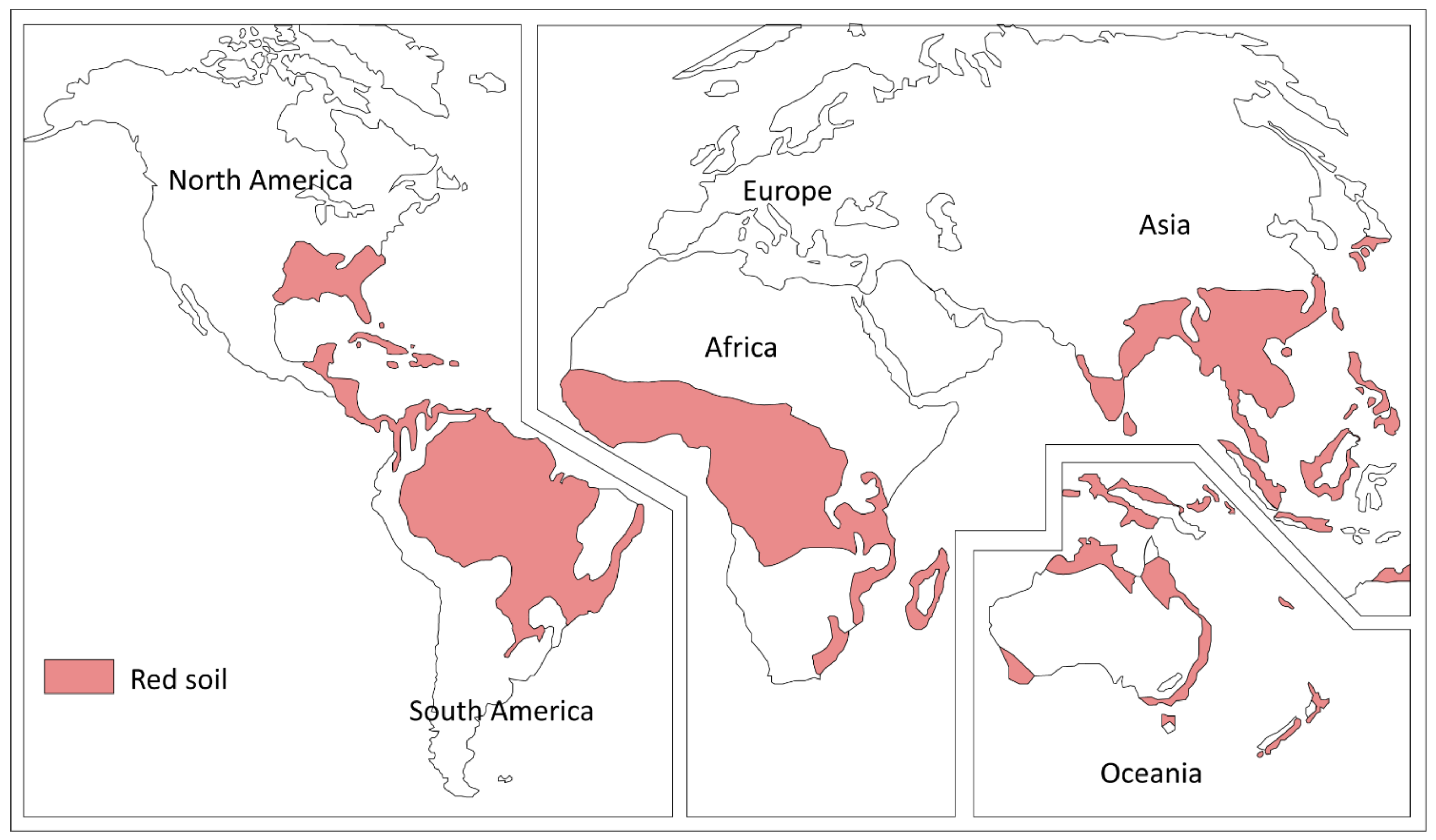
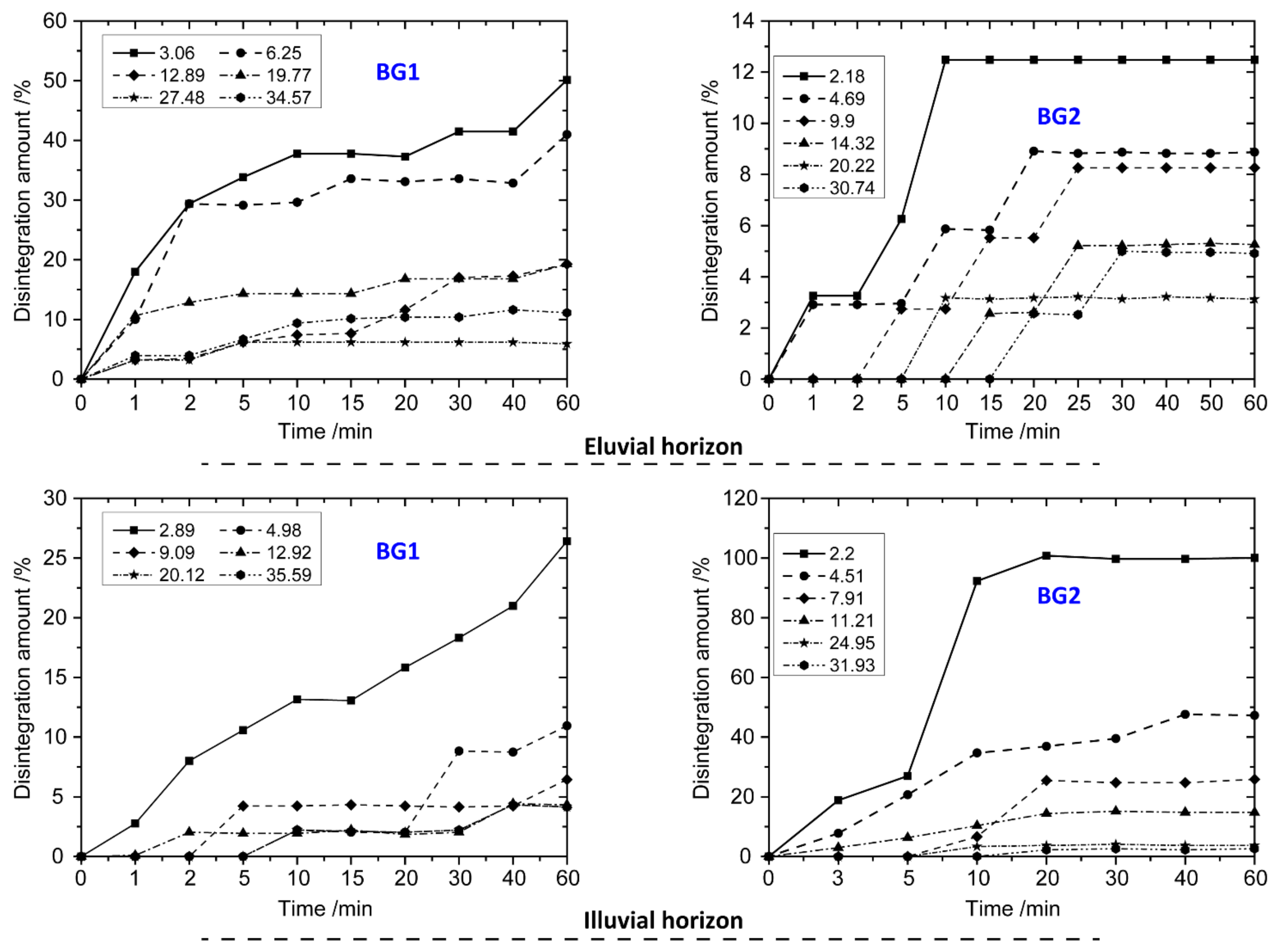
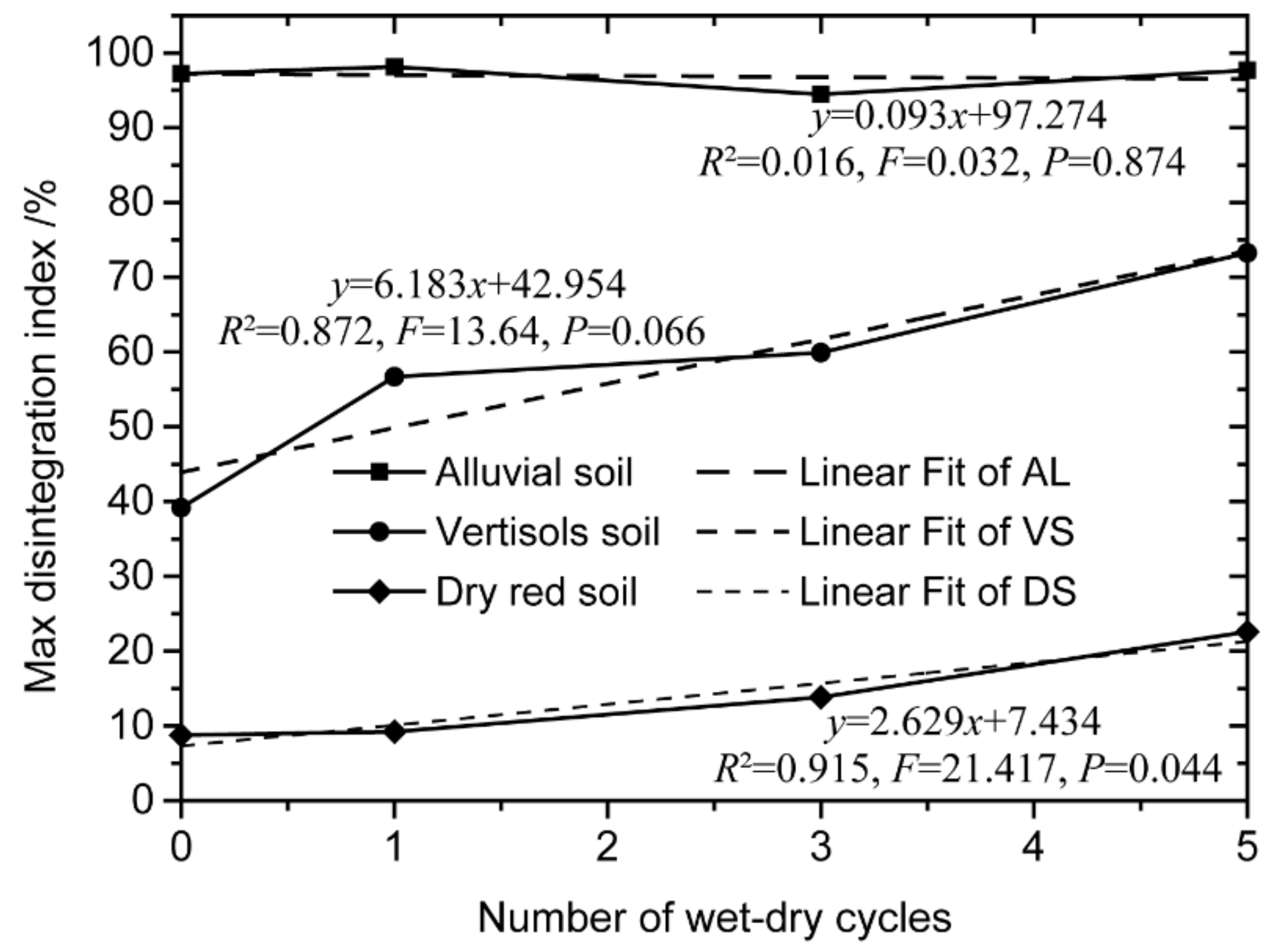
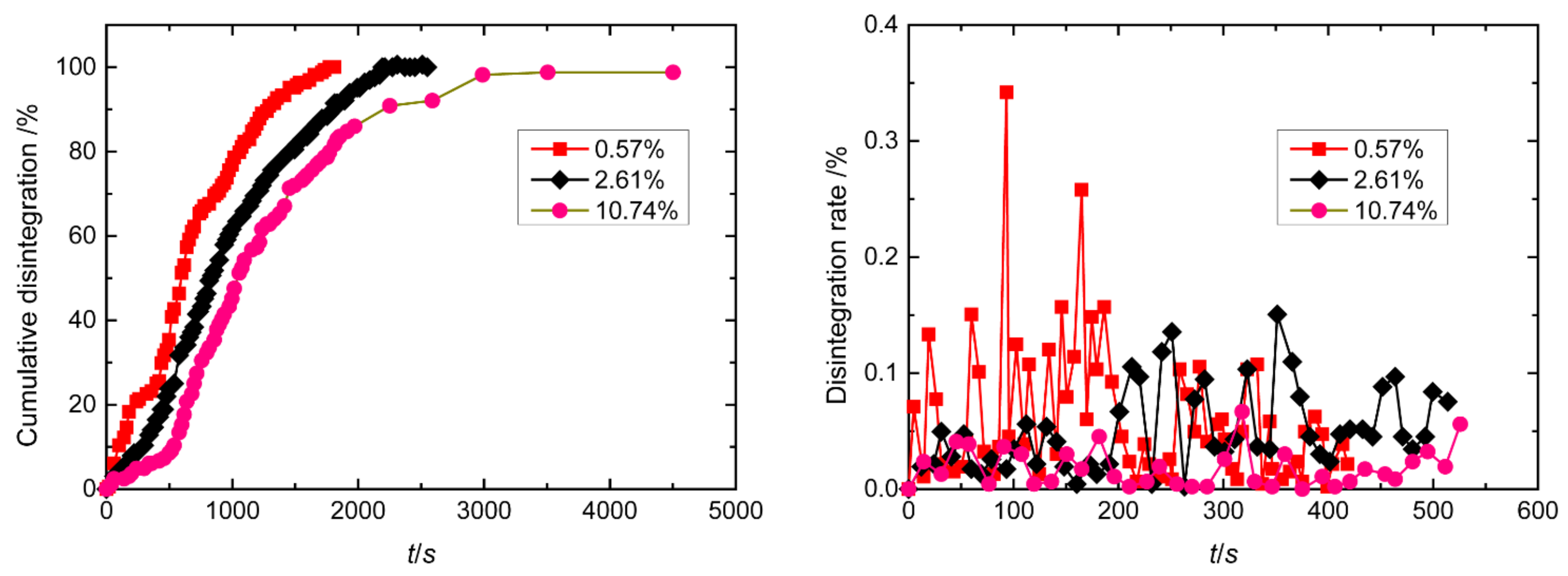
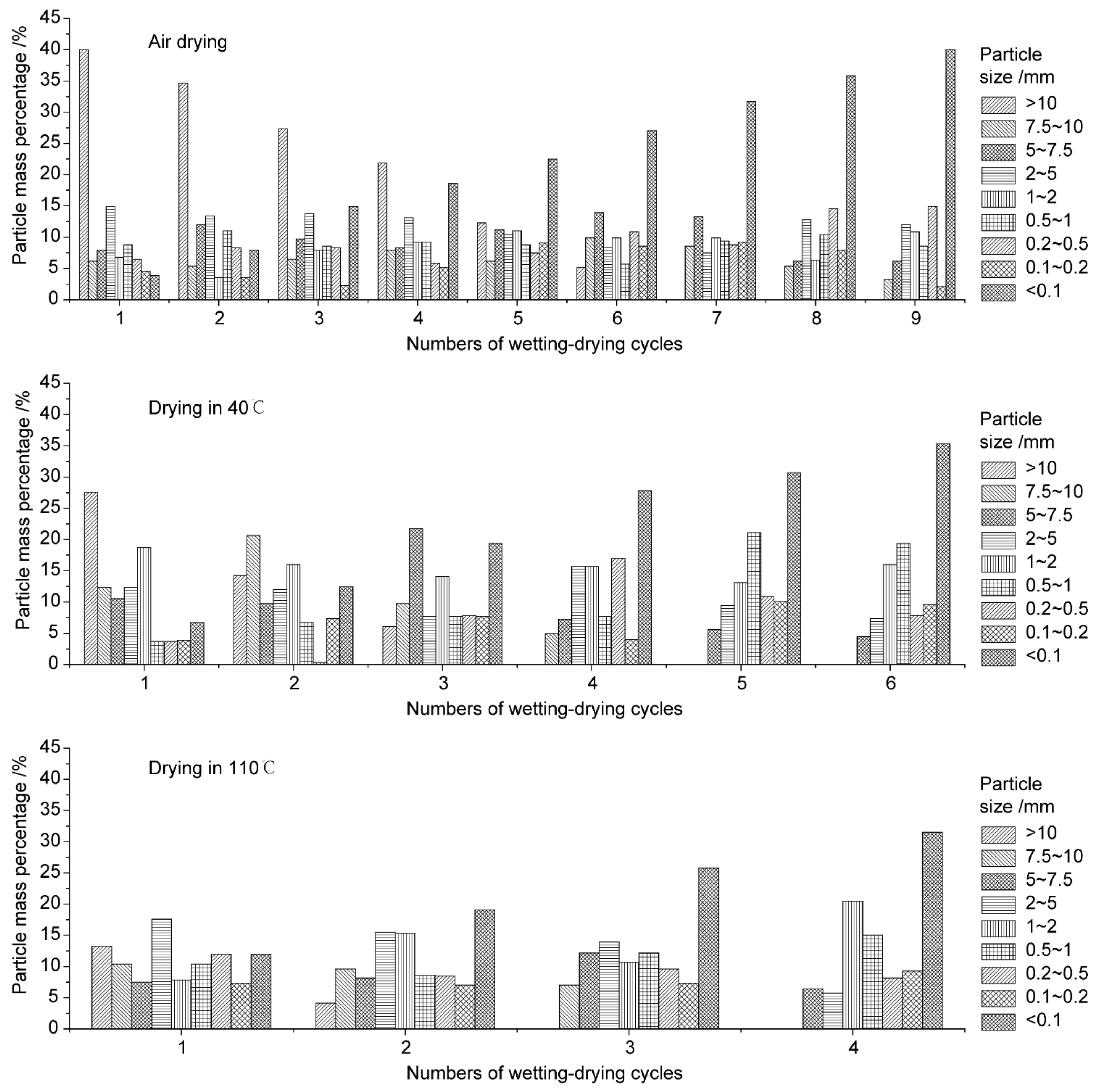
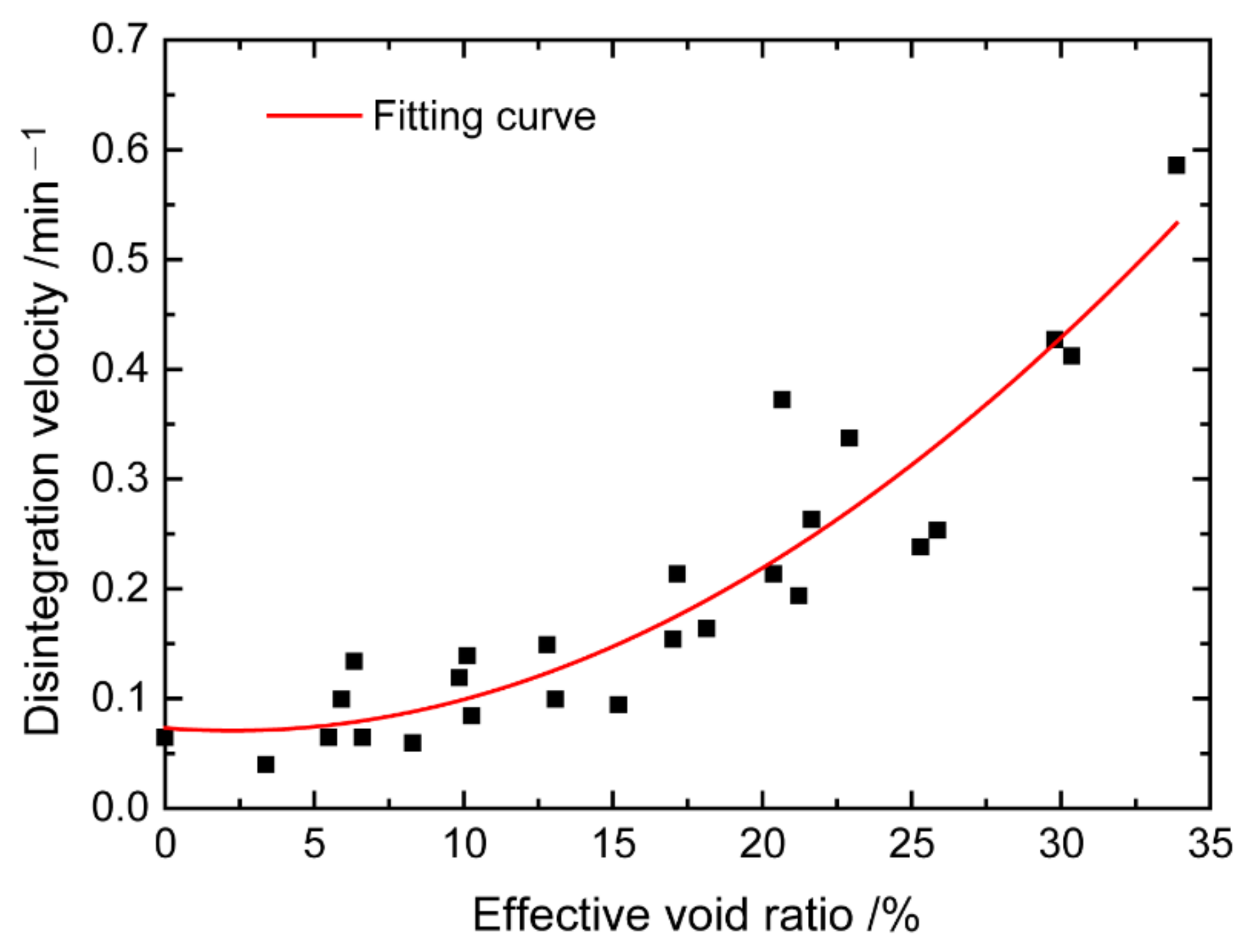
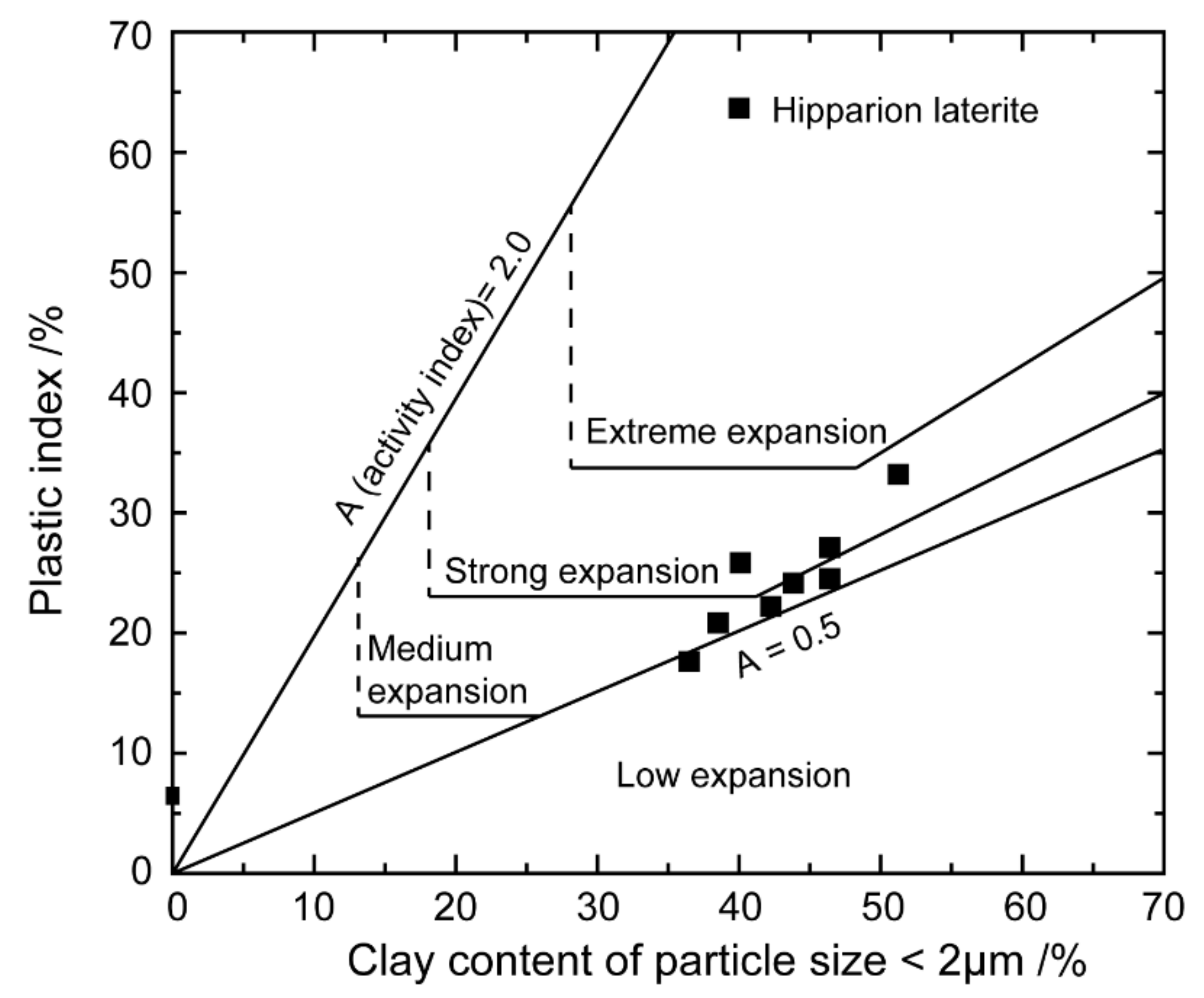
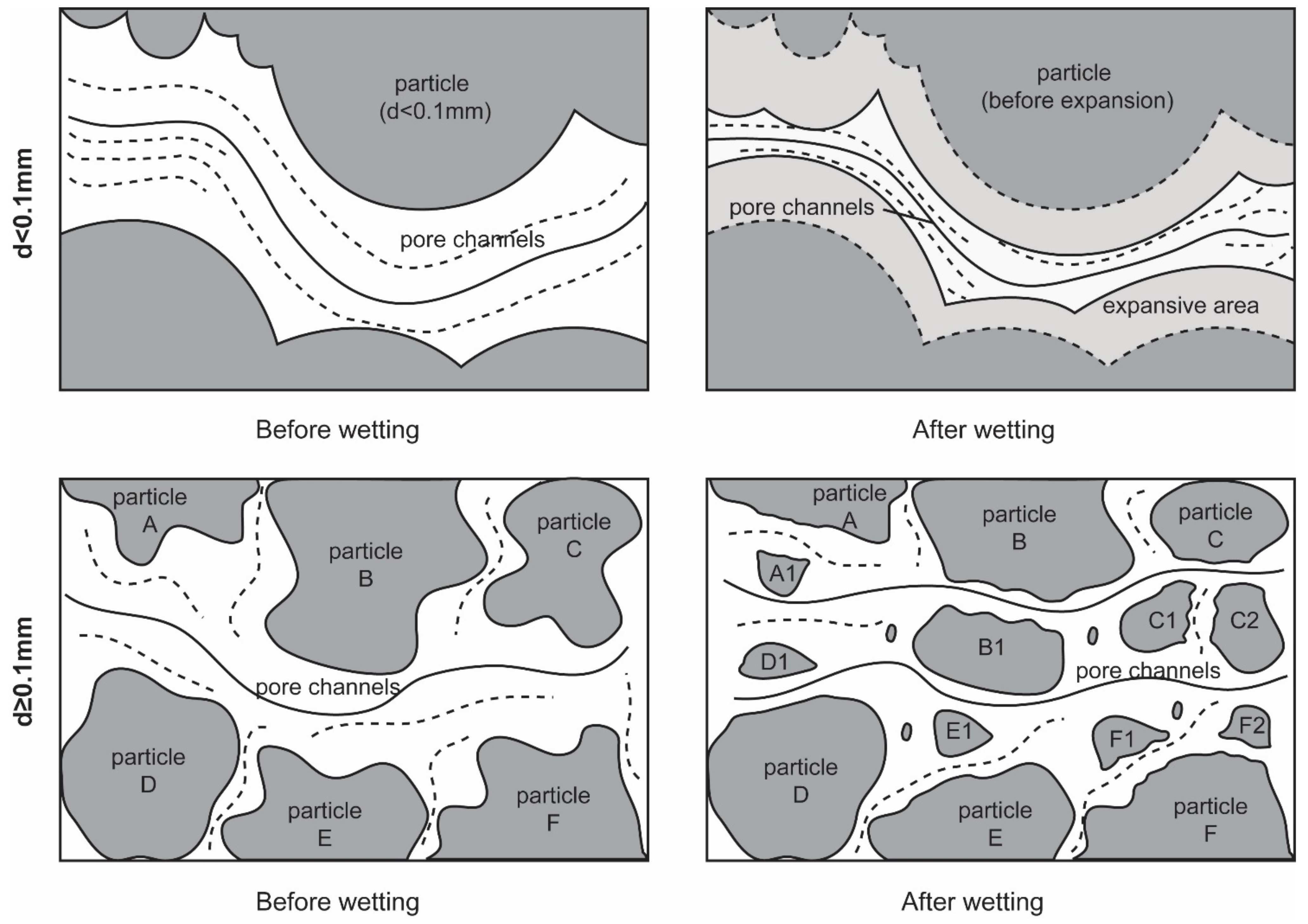
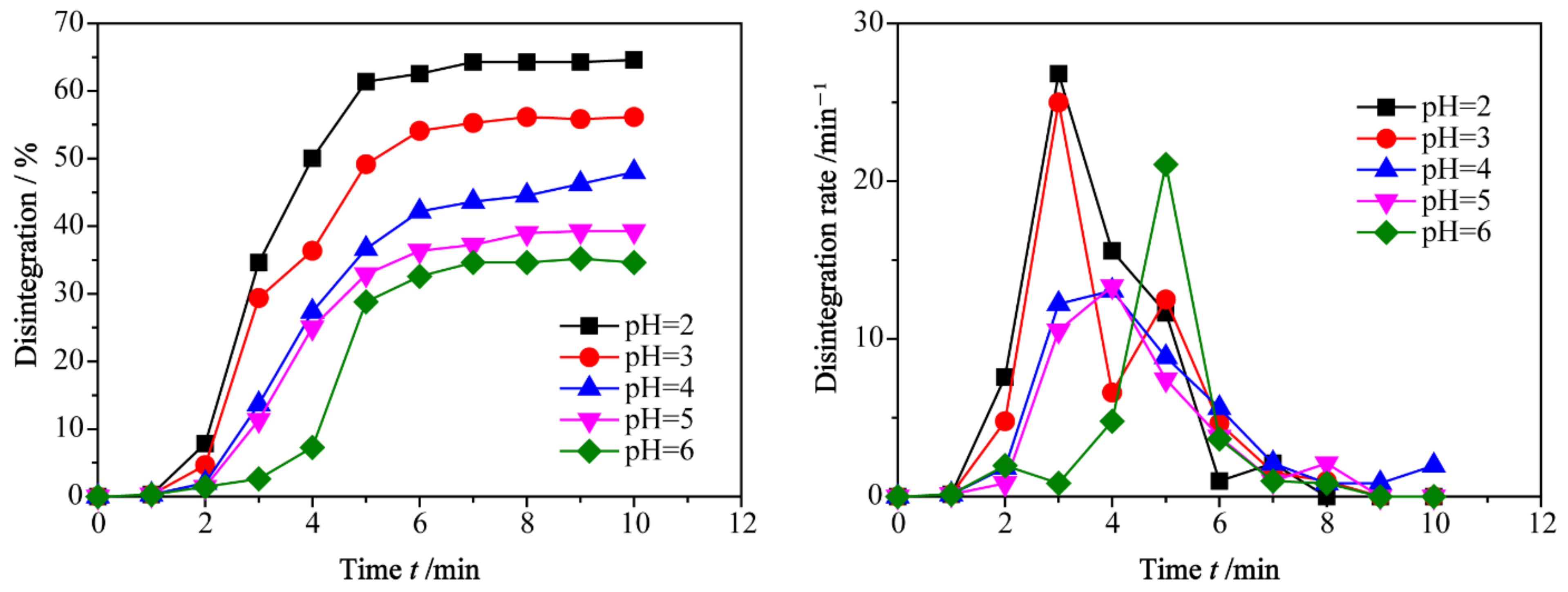

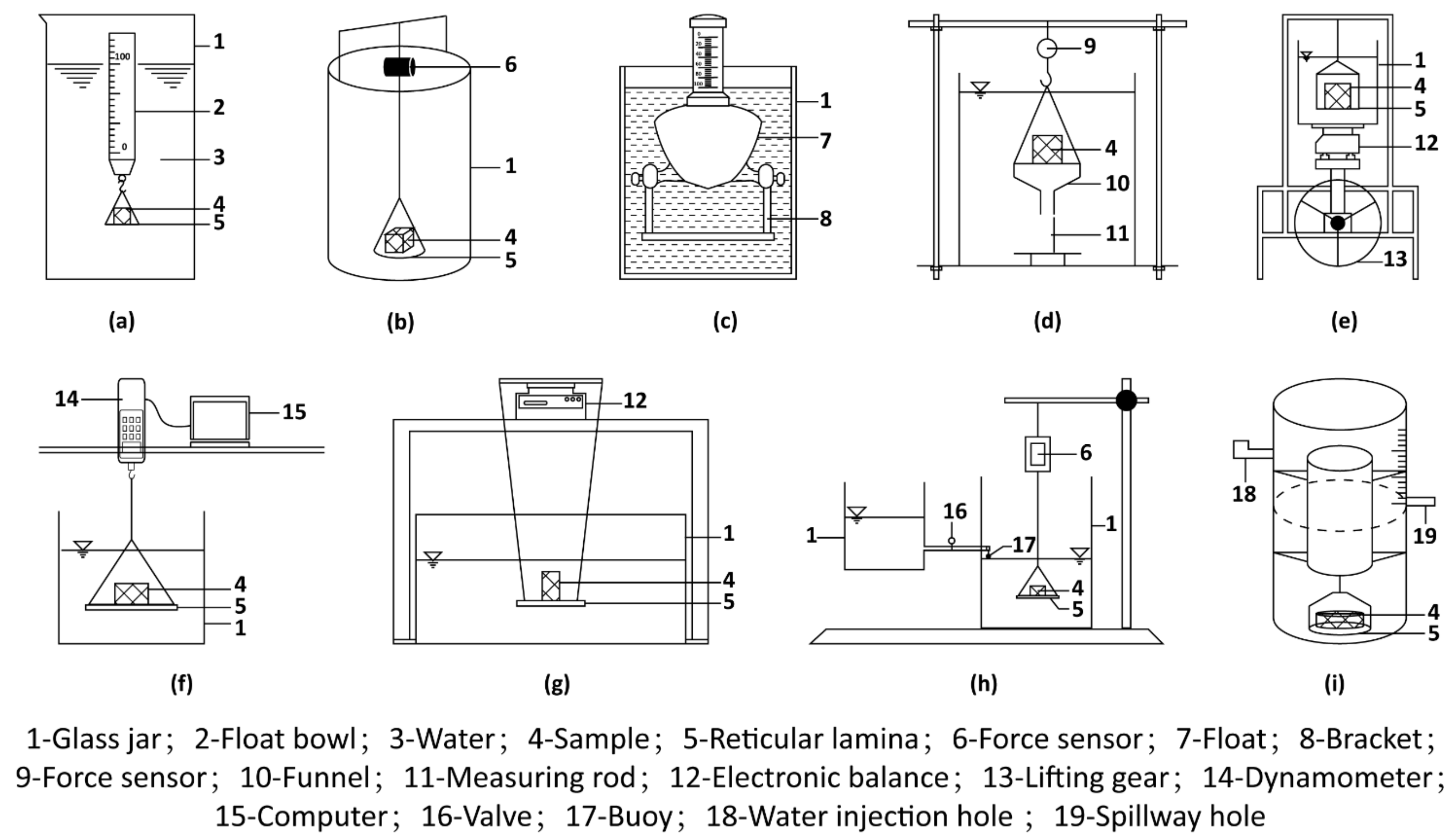
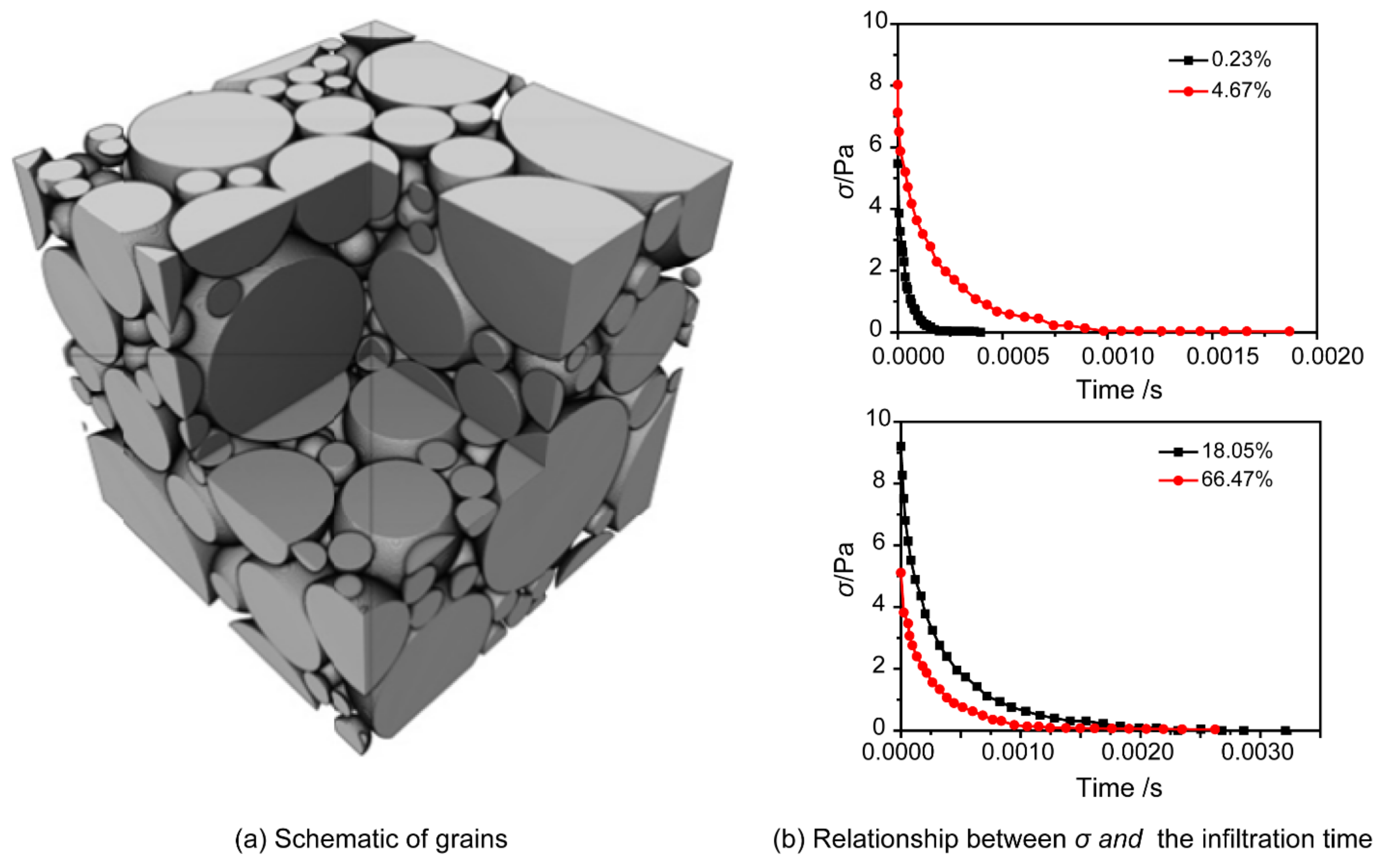

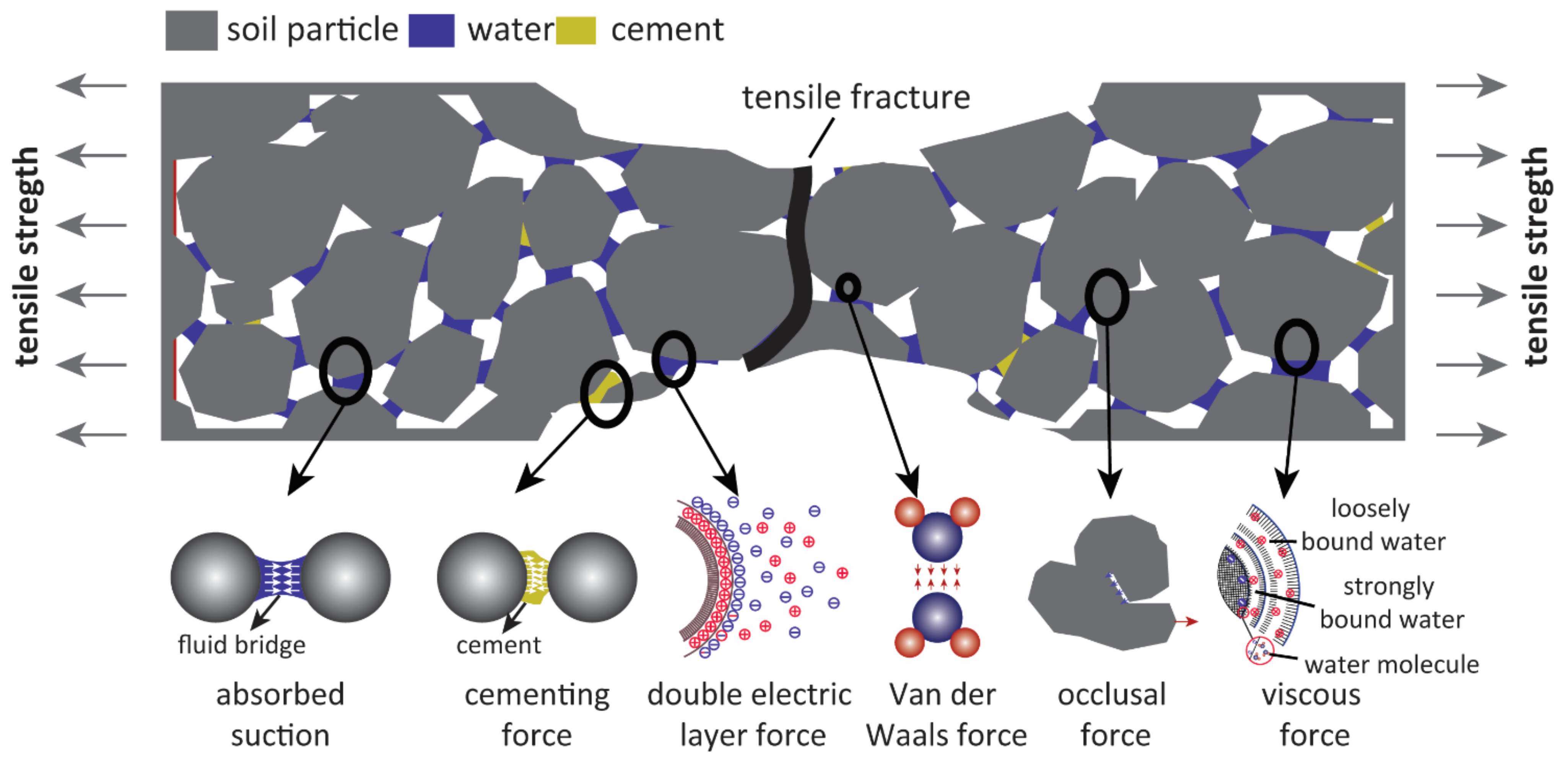
Publisher’s Note: MDPI stays neutral with regard to jurisdictional claims in published maps and institutional affiliations. |
© 2022 by the authors. Licensee MDPI, Basel, Switzerland. This article is an open access article distributed under the terms and conditions of the Creative Commons Attribution (CC BY) license (https://creativecommons.org/licenses/by/4.0/).
Share and Cite
Sun, Y.; Tang, L.; Xie, J. Relationship between Disintegration Characteristics and Intergranular Suction in Red Soil. Sustainability 2022, 14, 14234. https://doi.org/10.3390/su142114234
Sun Y, Tang L, Xie J. Relationship between Disintegration Characteristics and Intergranular Suction in Red Soil. Sustainability. 2022; 14(21):14234. https://doi.org/10.3390/su142114234
Chicago/Turabian StyleSun, Yinlei, Liansheng Tang, and Jianbin Xie. 2022. "Relationship between Disintegration Characteristics and Intergranular Suction in Red Soil" Sustainability 14, no. 21: 14234. https://doi.org/10.3390/su142114234
APA StyleSun, Y., Tang, L., & Xie, J. (2022). Relationship between Disintegration Characteristics and Intergranular Suction in Red Soil. Sustainability, 14(21), 14234. https://doi.org/10.3390/su142114234





